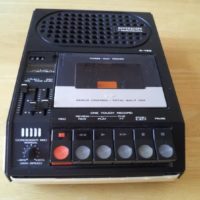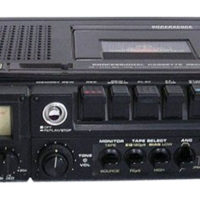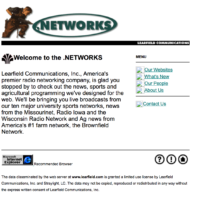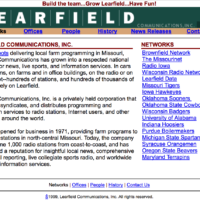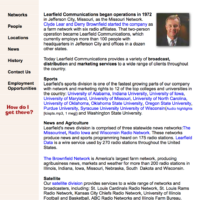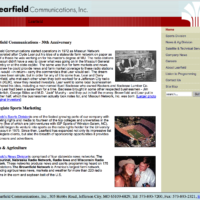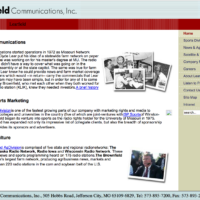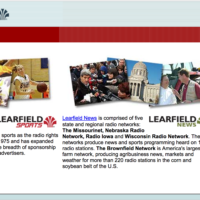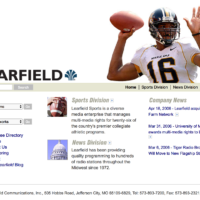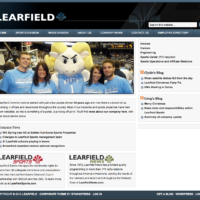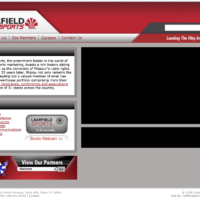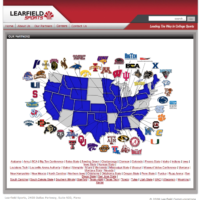I had the privilege of working with Bob Priddy for 29 years. Last Saturday he was inducted in the the Missouri Broadcasters Association Hall of Fame (along with two others). You can listen to his full remarks here. The clip below runs 2 minutes. [Text of Mr. Priddy’s remarks]
Category Archives: Learfield
Tom Boman, VP Operations, Learfield Sports
Tom Boman is Vice President of Broadcast Operations for Learfield Sports. He and the people that work with him are responsible for all of the game broadcasts and coaches shows for many of the top colleges and universities in country. He’ll be overseeing broadcasts for 130 schools this fall.
Based on my 40 years in and around radio, I’d say sports play-by-play announcer might be the most coveted — and hard to get — job in broadcasting. And Tom knows as much about what it takes to land one of those jobs as anybody. If you’ve ever wanted to be a “sportscaster” or know someone who does or if you just like listening to sports on the radio, you might enjoy this interview. It runs 20 minutes.
Portable cassette recorders
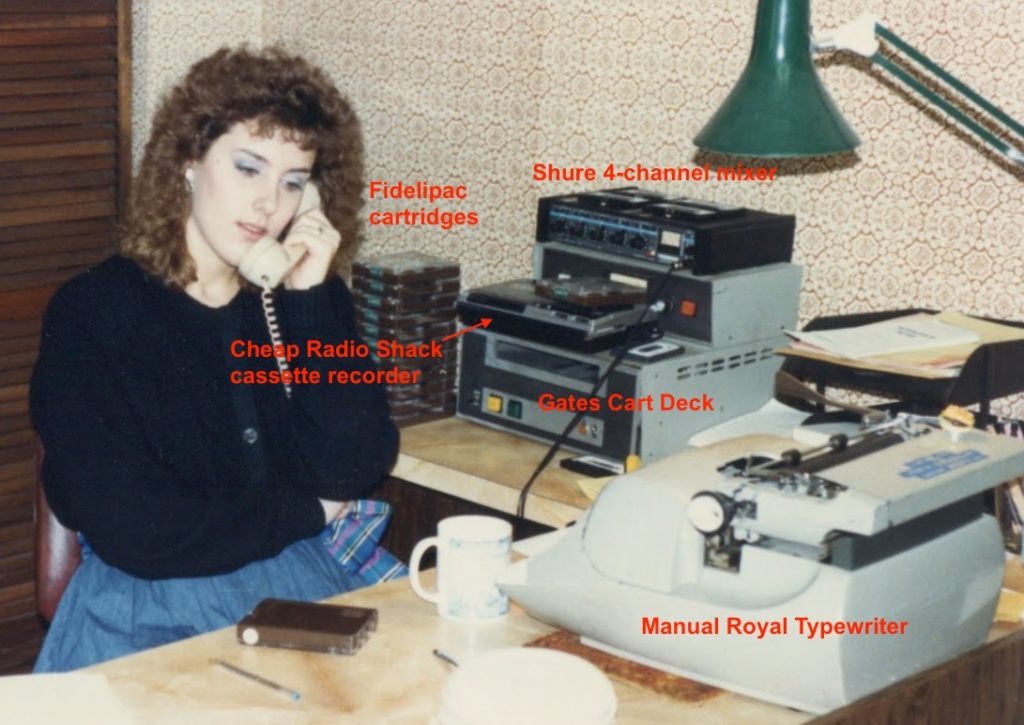
Came across this old photo (circa 1988) today and was — once again — struck by the gear we used. This is Lisa Wolfe, a reporter for The Missourinet.
The Radio Shack recorder is jacked into the Shure mixer which is wired into the big cart deck and the phone. So a reporter recorded audio from the phone (with a push-to-talk button in the hand piece); they then dubbed the audio bits they wanted to carts which they carried into the studio for newscasts. When they went into the field they unplugged the cassette recorder.
There were better recorders available but they were all much more expensive than the Radio Shack model which was damn near disposable. The problem was the buttons. Using the recorders as the did (endlessly starting, stopping, fast-forwarding, rewinding) trashed the buttons in no time.
The early SuperScopes (by Marantz) were good but every time they came out with a new model with more features, the buttons got flimsier and flimsier. And the recorders got more and more expensive. And they were nearly impossible to repair. So… Radio Shack.
Thinking back on those days, it occurs to me the cassette recorder was — in some ways — the laptop computer of that day. In the sense that it was our main tool for creating the content of the day (for us): audio.
Of course you needed a radio station or (in our case) a network of radio stations. But we sort of took that for granted.
ACT! and Reflex
 In the late 80’s I was doing affiliate relations for about 120 radio stations (in Missouri and Iowa). I had a card for each station in a Rolodex on my desk. Using a typewriter, I packed as much information on each card as possible. Station manager, program director, news director, address, phone, fax (few if any email addresses in ’87). By my right knee was a file drawer containing manila file folders for each station. This would contain copies of all correspondence; notes from phone calls and f2f visits. It was a paper world. The portable version of the Rolodex was a page with as much of the info as could be crammed on a sheet of paper. (Columns: City, GM, PD, ND, Address, Phone, Fax, etc)
In the late 80’s I was doing affiliate relations for about 120 radio stations (in Missouri and Iowa). I had a card for each station in a Rolodex on my desk. Using a typewriter, I packed as much information on each card as possible. Station manager, program director, news director, address, phone, fax (few if any email addresses in ’87). By my right knee was a file drawer containing manila file folders for each station. This would contain copies of all correspondence; notes from phone calls and f2f visits. It was a paper world. The portable version of the Rolodex was a page with as much of the info as could be crammed on a sheet of paper. (Columns: City, GM, PD, ND, Address, Phone, Fax, etc)
I had a computer on my desk but I don’t recall when I moved from DOS to Windows. But somewhere in here I was using Borland Reflex, a flat-file database management system for DOS. It was the first commercial PC database to use the mouse and graphics mode, and drag-and-drop capability in the report formatting module.
I used Reflex as a ‘customer relationship management’ program before there was such a thing (that I knew of). I was in heaven. I sorted and searched and generated reports. I used one field for notes (every phone call, letter and in-person visit).
Sometime around 1987 I was visiting Bill Weaver, the GM of KFRU in Columbia, MO, and I must have mentioned my little database. Bill showed me the program he used to manage all of his contacts: ACT! I was smitten! Did all the things I hacked out of Reflex but so much more. I immediately bought a copy and became insufferable to my co-workers.
While attending COMDEX in 1992 (Chicago), I saw what I believe was the first Windows version of ACT! $500 but I had to have it. Bought it on the convention floor.
I lived in ACT! for many years after. Probably well after Outlook took over the company network. Grown men were reduced to tears when they were forced to give up ACT!
Allen Hammock Interview
In 1995 CompuServe, America Online and Prodigy started providing dial-up Internet access and people started getting online. In April some tech folks from the University of Missouri came to our offices in Jefferson City and gave us a demo of the “World Wide Web” and our first look at Netscape Navigator. I can’t speak for the others in the meeting but I was mightily impressed.
I knew a bit about the Internet but nothing about how to create a website or register a domain, so I contacted Mike McKean, a professor at the J-School at the University of Missouri, and asked if he could put me in touch with a student who knew how to do this stuff. He introduced me to Dan Arnall, a senior journalism major. Dan was technically adept but he brought along Allen Hammock who was majoring in computer science. Dan and Allen were high school classmates in Springfield, Missouri, and were in members of a student leadership organization at Mizzou.
In this 12 minute interview, Allen shares some of his recollections of the exciting three years that followed.
Wayback Machine: Learfield.com
My little history project took me to the Internet Archive Wayback Machine where I got a look at some of the websites I helped create and maintain during the early days of the Internet. The first sites we created were for our two news networks, Radio Iowa and The Missourinet, but we felt like we needed one for our corporate site and Learfield.com went up in 1997. It was designed and built by Dan Arnall and Allen Hammock. (The story is in the link above)
- 1997
- 1999
- 2000
- 2002
- 2003
- 2005
- 2006
- 2010
- 2011
- 2011
I’m pretty sure I’m responsible for the look of the page in 1999 and 2000. I had zero design training or skills and I also didn’t have a budget for those talents, so I took a whack at it. We did have some professional help eventually but today they all look, let’s just say, dated.
A “home page” on the Internet was a brand new thing in 1997. They became the public face of a company or organization and in those early days, little more than brochures. Everyone was trying to figure out how to make them useful. “Look and feel” was way more important than usability back then. We loaded our pages with text because space was not an issue. Or so we thought.
Images tended to be tiny because big ones too a long time to load on slow dial-up connections. As we added more and more pages to our sites, “navigation” became important. We gave our page links clever names that meant nothing to the people visiting our sites.
Looking at these are almost painful. Like looking at photos from your senior year in high school. Want more? Missourinet and Radio Iowa.
Mark Cuban and AudioNet
The following is an excerpt from Learfield and the Internet: 1995-2005
In September of 1995 we received a phone call from Mark Cuban. He and a partner (Todd Wagner) had recently acquired a company called Cameron Audio Networks, named after its founder Cameron Christopher Jaeb. The company had acquired rights to broadcast radio and professional sports games live on the Internet. Cuban wanted to listen to the basketball games of his alma mater, Indiana University. Learfield owned the media rights to IU (and eight other universities and colleges). Cuban renamed his company AudioNet.
From the AudioNet media kit, October 1995:
“AudioNet is one of the most popular destinations on the Internet. People around the world know that when they want their choice of realtime and on demand audio programming there is only one place to go, WWW.Audionet.Com, the world’s first Broadcast Network on the Internet!”
“We offer them realtime broadcasts of radio stations such as KLIF Dallas, KFI Los Angeles, KOA Denver, XTRA San Diego, WQAM Miami, WJFK Washington DC WCKY Cincinnati, with many more to come. The there is the realtime broadcasts of exciting sporting events such as Texas A&M, University of Southern California, Baylor, Southern Methodist University college football, a growing schedule of professional football, baseball, basketball ad hockey, and Indoor Soccer.”
“In addition to sports programming we offer a complete choice of entertaining programming (you) can’t get anywhere else, like the Janice Malone Show, The Mark Cuban Show, Jeffrey Lyons Movie Reviews and Hollywood Reports, Medical Matters, Tech Talk, NetRadio, Geek Free Radio, Legal Matters, NetRadio, Celebrity Interviews with Michelle Pfeiffer, Patrick Swayze, Dustin Hoffman, George Foreman, Gennifer Flowers and much more. What’s even more exciting is that AudioNet is doubling (its) content offerings every month, with new things being added every day. Listeners know to stop by and see what’s new, and they do!”
On November 10, 1995, we met with Mark in Kansas City to discuss how our two companies might work together. It was Clyde, Allen Hammock, Steve Mays and (maybe) Chief Engineer Charlie Peters.
Since Learfield owned the broadcast rights, we couldn’t see the value of what AudioNet brought to the table. At one point Mark walked over to the whiteboard and scrawled some numbers, offering to sell 10% of his new company to Learfield for half a million dollars (others recall the number as one million). Learfield didn’t have the money at the time and really couldn’t see the value of AudioNet in any event. (Cuban sold his company to Yahoo! on April 1, 1999 for $5.7 billion, making it the most expensive acquisition Yahoo! had made at the time.)
In December, 1995, Learfield and AudioNet signed a letter of agreement for Internet distribution of our live college sports programming. AudioNet provided a minimum of 10,000 RealAudio streams while Learfield provided audio of our football and basketball broadcasts. We were also responsible for development of all content for the websites. Any advertising sold by Learfield, the split was 80/20 (80% to Learfield). If AudioNet sold the ads, the split was 60/40 (60% to Learfield). The term of the agreement was two years.
At some point during our talks with Mark, someone at Learfield asked why we couldn’t just do this on our own. Why did we need AudioNet? I recall Mark explaining he had an arrangement with RealAudio for streaming licenses that no other company could get. That was his edge.
Tweeting the execution
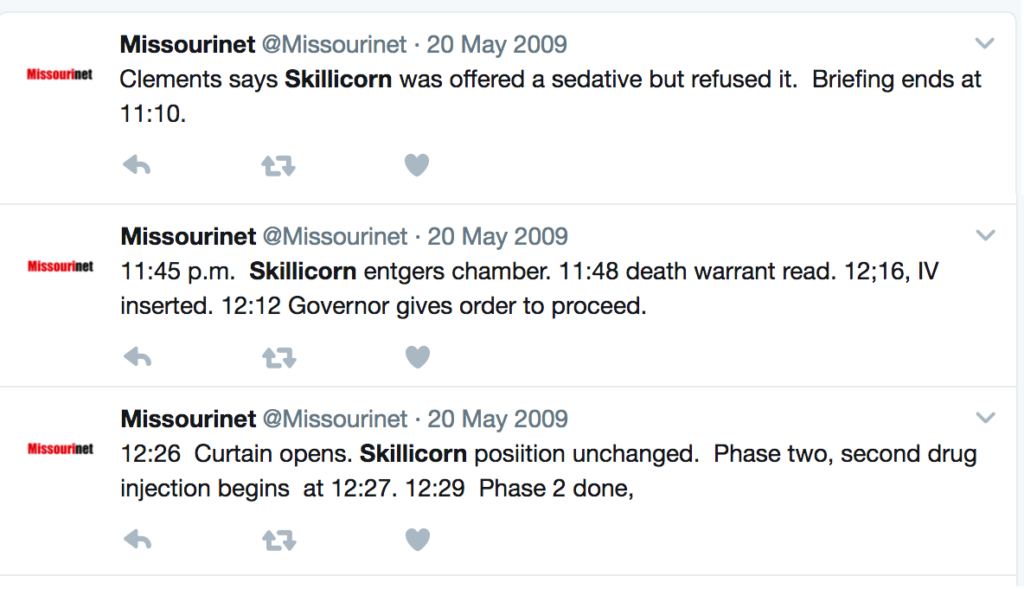
My Small History of Learfield and the Internet is nearing completion. Every drawer I open has some interesting new tidbit. Missourinet News Director Bob Priddy (now retired) share’s this gruesome bit of history:
“One of the highlights of our coverage of executions was when I became ( I think) the first reporter in the world who tweeted an execution. Dennis Skillicorn was executed in May, 2009. I could not take anything into the witness room except my notebook and a pen, and the book I had been reading in the waiting room, but I kept a careful chronology and as soon as we came out, I posted tweets on a minute-by-minute basis describing the events.
I stopped using Twitter in November of 2016 because it had become toxic with politics. Might return someday, might not. But searching for these Tweets reminds me of it’s historical importance.
When newsletters were printed and mailed
In 1988 if I wanted to communicate with the 60 radio stations affiliated with our news networks, I printed it and put it in an envelope and mailed it (USPS). Took as long as four days to reach some stations. No fax machines yet and email still years away.
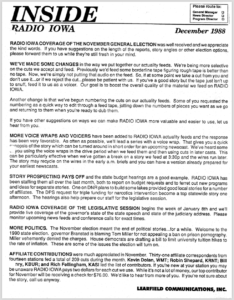 This has such a Pony Express feel to me, here in 2017. The idea of a monthly, printed newsletter seems… quaint. But I recall almost every company and association doing a monthly (sometimes quarterly) newsletter. Somebody spent hours writing these things, often with multiple managers “signing off” before they went out.
This has such a Pony Express feel to me, here in 2017. The idea of a monthly, printed newsletter seems… quaint. But I recall almost every company and association doing a monthly (sometimes quarterly) newsletter. Somebody spent hours writing these things, often with multiple managers “signing off” before they went out.
When desktop publishing (and laser printers) came along, newsletters got ugly, fast. That was my opinion and I my philosophy was text-only; short paragraphs; one page, front and back. I read somewhere, “No more than an hour to write and a minute to read.” I think I knew, in my secret heart, that nobody read these things anyway. But I did them, every month for years. I kept most of them and they provide tiny snapshots of what was going one with our networks at the time.
Today we have Facebook pages and Twitter feeds and maybe even a blog or two. But I’m seeing some Big Names moving back to newsletters. Easier to monetize? More likely to be read?
Clyde’s first business plan
It’s pretty easy to come up with an idea for a new business. It’s really hard to write good business plan for a new business. In 1972, 28-year-old Clyde Lear put together a proposal for regional radio network. He showed it to a half dozen local businessmen who invested in him and his idea. Last year Clyde’s company was valued at more than one billion dollars. It’s not really his company anymore, he sold it a few years ago.
Clyde kept that first business plan and it’s interesting reading. I worked for Clyde for 30 years and have known him for 40 so it might be more interesting to me than you. He’s graciously allowed me to share some of it here. It begins with the concept, his “big idea.” An excerpt:
Regional news and farm networks have been especially lucrative. The growing farm economy required quick dissemination of farm information. Much of this information is a necessity to the agribusinessman. Further, the advertiser wanting to market his good — machinery, seeds, services, fertilizer, feed, chemicals — looks for the way he can get the greatest number of farmers and ranchers to hear his message at the lowest possible cost. The regional farm network is the answer.
Advertising rates, proposed programs, projected expenses, descriptions of other networks. In 1972 there were 113 radio networks in the U. S. and Clyde researched eleven of them. An example:
Ohio Farm Network: This is a full-time farm network, but distribution is by tape, and five days late. Programming is entirely morning about 20 minutes in length. It is entirely a pre-sold program, based on a percentage of the rate card of each station. One man handles all the programming and all the selling. The overhead is low, and sales, by comparison to the others, are moderate at best, seldom reaching $10,000 per month.
If you’ve ever thought about starting your own business, or if you started your own business, you might find this bit of history interesting. The company that Clyde and others built from his original idea doesn’t look much like his original dream but that was never a static thing. You can download Clyde’s original plan here.

